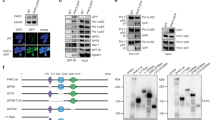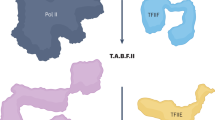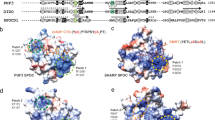Abstract
The presence of actin in the nucleus has been well established, and several studies have implicated nuclear actin in transcriptional regulation1,2,3. Neuronal Wiskott–Aldrich syndrome protein (N-WASP) is a member of the WASP family of proteins; these proteins function in the cytoplasm as key regulators of cortical actin filament4,5,6. Interestingly, N-WASP has also been observed in the nucleus7,8,9,10,11. However, a potential nuclear function for N-WASP has not been established. Here, we report the identification of nuclear N-WASP within a large nuclear-protein complex containing PSF–NonO (polypyrimidine-tract-binding-protein-associated splicing factor–non-Pou-domain octamer-binding protein/p54nrb), nuclear actin and RNA polymerase II. The PSF–NonO complex is involved in the regulation of many cellular processes12, such as transcription, RNA processing, DNA unwinding and repair. We demonstrate that the interaction of N-WASP with the PSF–NonO complex can couple N-WASP with RNA polymerase II to regulate transcription. We also provide evidence that the potential function of N-WASP in promoting polymerization of nuclear actins has an important role in this process. Based on these results, we propose a nuclear function for N-WASP in transcriptional regulation.
This is a preview of subscription content, access via your institution
Access options
Subscribe to this journal
Receive 12 print issues and online access
$209.00 per year
only $17.42 per issue
Buy this article
- Purchase on Springer Link
- Instant access to full article PDF
Prices may be subject to local taxes which are calculated during checkout





Similar content being viewed by others
References
Blessing, C. A., Ugrinova, G. T. & Goodson, H. V. Actin and ARPs: action in the nucleus. Trends Cell Biol. 14, 435–442 (2004).
Bettinger, B. T., Gilbert, D. M. & Amberg, D. C. Actin up in the nucleus. Nature Rev. Mol. Cell Biol. 5, 410–415 (2004).
Pederson, T. & Aebi, U. Actin in the nucleus: what form and what for? J. Struct. Biol. 140, 3–9 (2002).
Rohatgi, R. et al. The interaction between N-WASP and the Arp2/3 complex links Cdc42-dependent signals to actin assembly. Cell 97, 221–231 (1999).
Takenawa, T. & Miki, H. WASP and WAVE family proteins: key molecules for rapid rearrangement of cortical actin filaments and cell movement. J. Cell Sci. 114, 1801–1809 (2001).
Millard, T. H., Sharp, S. J. & Machesky, L. M. Signalling to actin assembly via the WASP (Wiskott–Aldrich syndrome protein)-family proteins and the Arp2/3 complex. Biochem. J. 380, 1–17 (2004).
Wu, X., Suetsugu, S., Cooper, L. A., Takenawa, T. & Guan, J. L. Focal adhesion kinase regulation of N-WASP subcellular localization and function. J. Biol. Chem. 279, 9565–9576 (2004).
Bear, J. E., Krause, M. & Gertler, F. B. Regulating cellular actin assembly. Curr. Opin. Cell Biol. 13, 158–166 (2001).
Vetterkind, S. et al. The rat homologue of Wiskott–Aldrich syndrome protein (WASP)-interacting protein (WIP) associates with actin filaments, recruits N-WASP from the nucleus, and mediates mobilization of actin from stress fibers in favor of filopodia formation. J. Biol. Chem. 277, 87–95 (2002).
Miki, H., Miura, K. & Takenawa, T. N-WASP, a novel actin-depolymerizing protein, regulates the cortical cytoskeletal rearrangement in a PIP2-dependent manner downstream of tyrosine kinases. EMBO J. 15, 5326–5335 (1996).
Suetsugu, S. & Takenawa, T. Translocation of N-WASP by nuclear localization and export signals into the nucleus modulates expression of HSP90. J. Biol. Chem. 278, 42515–42523 (2003).
Shav-Tal, Y. & Zipori, D. PSF and p54(nrb)/NonO-multi-functional nuclear proteins. FEBS Lett. 531, 109–114 (2002).
Zhang, W. W., Zhang, L. X., Busch, R. K., Farres, J. & Busch, H. Purification and characterization of a DNA-binding heterodimer of 52 and 100 kDa from HeLa cells. Biochem. J. 290, 267–272 (1993).
Peng, R. et al. PSF and p54nrb bind a conserved stem in U5 snRNA. RNA 8, 1334–1347 (2002).
Emili, A. et al. Splicing and transcription-associated proteins PSF and p54nrb/nonO bind to the RNA polymerase II CTD. RNA 8, 1102–1111 (2002).
Percipalle, P. et al. An actin-ribonucleoprotein interaction is involved in transcription by RNA polymerase II. Proc. Natl Acad. Sci. USA 100, 6475–6480 (2003).
Miki, H. & Takenawa, T. Direct binding of the verprolin-homology domain in N-WASP to actin is essential for cytoskeletal reorganization. Biochem. Biophys. Res. Commun. 243, 73–78 (1998).
Hofmann, W. A. et al. Actin is part of pre-initiation complexes and is necessary for transcription by RNA polymerase II. Nature Cell Biol. 6, 1094–1101 (2004).
Scheer, U., Hinssen, H., Franke, W. W. & Jockusch, B. M. Microinjection of actin-binding proteins and actin antibodies demonstrates involvement of nuclear actin in transcription of lampbrush chromosomes. Cell 39, 111–122 (1984).
Hu, P., Wu, S. & Hernandez, N. A role for β-actin in RNA polymerase III transcription. Genes Dev. 18, 3010–3015 (2004).
Philimonenko, V. V. et al. Nuclear actin and myosin I are required for RNA polymerase I transcription. Nature Cell Biol. 6, 1165–1172 (2004).
Kukalev, A., Nord, Y., Palmberg, C., Bergman, T. & Percipalle, P. Actin and hnRNP U cooperate for productive transcription by RNA polymerase II. Nature Struct. Mol. Biol. 12, 238–244 (2005).
McDonald, D., Carrero, G., Andrin, C., de Vries, G. & Hendzel, M. J. Nucleoplasmic β-actin exists in a dynamic equilibrium between low-mobility polymeric species and rapidly diffusing populations. J. Cell Biol. 172, 541–552 (2006).
Pellizzoni, L., Charroux, B., Rappsilber, J., Mann, M. & Dreyfuss, G. A functional interaction between the survival motor neuron complex and RNA polymerase II. J. Cell Biol. 152, 75–85 (2001).
Yang, Y. S. et al. NonO, a non-POU-domain-containing, octamer-binding protein, is the mammalian homolog of Drosophila nonAdiss. Mol. Cell Biol. 13, 5593–5603 (1993).
Kameoka, S., Duque, P. & Konarska, M. M. p54(nrb) associates with the 5′ splice site within large transcription/splicing complexes. EMBO J. 23, 1782–1791 (2004).
Yang, Y. S., Yang, M. C., Tucker, P. W. & Capra, J. D. NonO enhances the association of many DNA-binding proteins to their targets. Nucleic Acids Res. 25, 2284–2292 (1997).
Kiseleva, E. et al. Actin- and protein-4.1-containing filaments link nuclear pore complexes to subnuclear organelles in Xenopus oocyte nuclei. J. Cell Sci. 117, 2481–2490 (2004).
Naar, A. M., Taatjes, D. J., Zhai, W., Nogales, E. & Tjian, R. Human CRSP interacts with RNA polymerase II CTD and adopts a specific CTD-bound conformation. Genes Dev. 16, 1339–1344 (2002).
Lee, K. A. & Green, M. R. Small-scale preparation of extracts from radiolabeled cells efficient in pre-mRNA splicing. Methods Enzymol. 181, 20–30 (1990).
Redmond, T., Tardif, M. & Zigmond, S. H. Induction of actin polymerization in permeabilized neutrophils. Role of ATP. J. Biol. Chem. 269, 21657–21663 (1994).
Mingle, L. A. et al. Localization of all seven messenger RNAs for the actin-polymerization nucleator Arp2/3 complex in the protrusions of fibroblasts. J. Cell Sci. 118, 2425–2433 (2005).
Acknowledgements
We are grateful to Dr K. Cerione at Cornell University for sharing reagents and equipment and for discussions. We thank our colleagues X. Peng, Z. Melkoumian, H. Wei and B. Gan for critical reading of the manuscript and helpful comments. This research was supported by National Institutes of Health grants to J.-L.G. (GM48050 and HL73394), G.L. and P.W.T.
Author information
Authors and Affiliations
Corresponding author
Ethics declarations
Competing interests
The authors declare no competing financial interests.
Supplementary information
Supplementary Information
Supplementary Figures S1, S2 and Supplementary Methods (PDF 491 kb)
Rights and permissions
About this article
Cite this article
Wu, X., Yoo, Y., Okuhama, N. et al. Regulation of RNA-polymerase-II-dependent transcription by N-WASP and its nuclear-binding partners. Nat Cell Biol 8, 756–763 (2006). https://doi.org/10.1038/ncb1433
Received:
Accepted:
Published:
Issue Date:
DOI: https://doi.org/10.1038/ncb1433
This article is cited by
-
The MEF2A transcription factor interactome in cardiomyocytes
Cell Death & Disease (2023)
-
Stabilization of SAMHD1 by NONO is crucial for Ara-C resistance in AML
Cell Death & Disease (2022)
-
Nuclear Vav3 is required for polycomb repression complex-1 activity in B-cell lymphoblastic leukemogenesis
Nature Communications (2022)
-
The effects of 808-nm near-infrared laser light irradiation on actin cytoskeleton reorganization in bone marrow mesenchymal stem cells
Cell and Tissue Research (2021)
-
The dendritic spine morphogenic effects of repeated cocaine use occur through the regulation of serum response factor signaling
Molecular Psychiatry (2018)



